Decision Making: A Manager's Role in Ethical Organizations Report
VerifiedAdded on 2020/03/16
|13
|2753
|139
Report
AI Summary
This report provides a comprehensive overview of the decision-making process, emphasizing the role of a manager in promoting ethical considerations within organizations. It details the various steps involved, including problem identification, information gathering, evaluation of alternatives, and the selection and execution of the best decision. The report uses a real-world scenario involving a health crisis to illustrate the practical application of these steps. It also highlights the importance of stakeholder involvement, transparency, and ethical considerations, such as the potential side effects of medical treatments and the need for informed consent. Furthermore, the report discusses brainstorming, the importance of organizational goals and culture, and the evaluation of results, concluding that effective decision-making is crucial for organizational success and requires a balance of ethical principles and practical considerations. The report stresses the importance of managerial responsibility in ensuring viable and ethical solutions, with due regard to the corporate goals and objectives.

DECISION MAKING 1
DECISION MAKING
By [Student’s name]
Professor’s name
Course Code
University
Date of submission
DECISION MAKING
By [Student’s name]
Professor’s name
Course Code
University
Date of submission
Paraphrase This Document
Need a fresh take? Get an instant paraphrase of this document with our AI Paraphraser
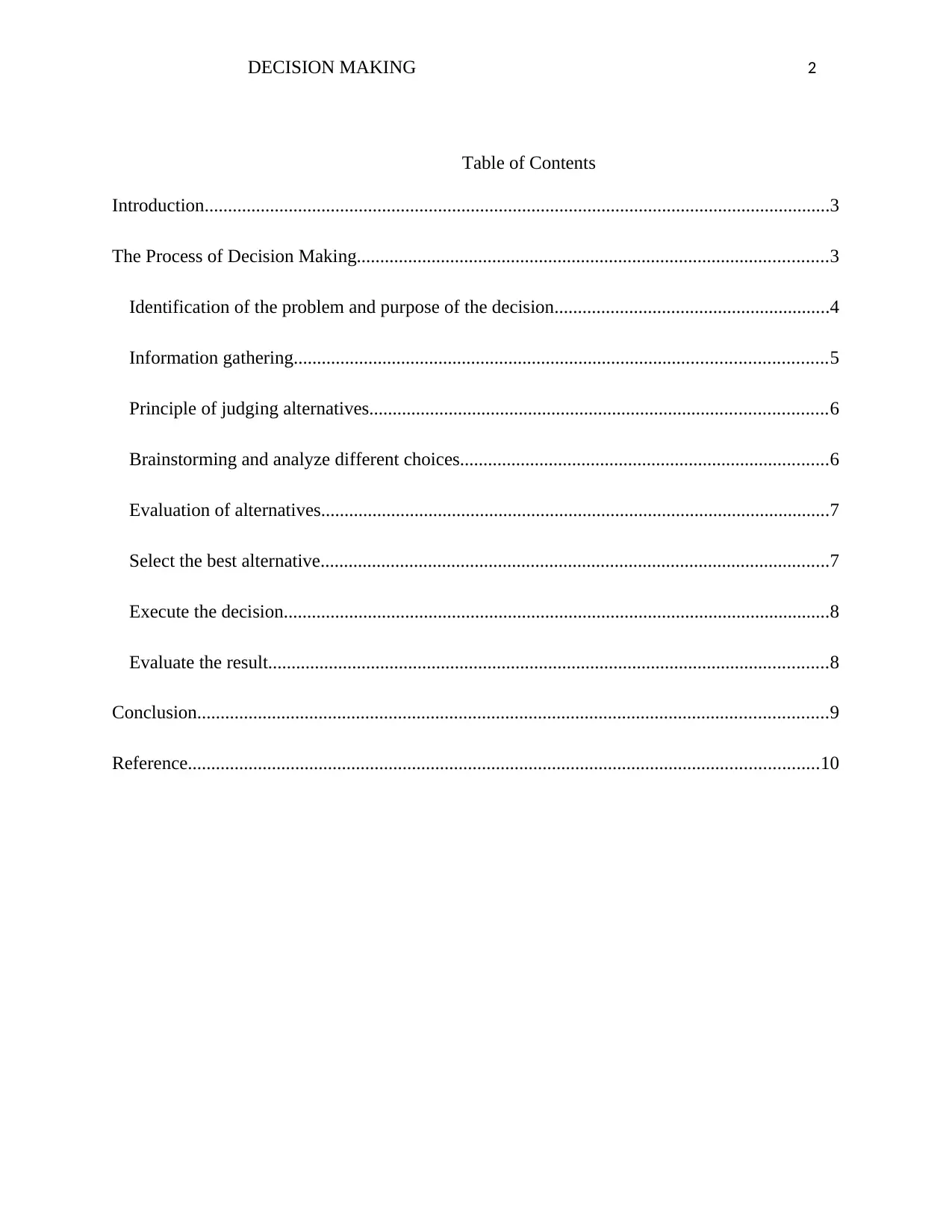
DECISION MAKING 2
Table of Contents
Introduction......................................................................................................................................3
The Process of Decision Making.....................................................................................................3
Identification of the problem and purpose of the decision...........................................................4
Information gathering..................................................................................................................5
Principle of judging alternatives..................................................................................................6
Brainstorming and analyze different choices...............................................................................6
Evaluation of alternatives.............................................................................................................7
Select the best alternative.............................................................................................................7
Execute the decision.....................................................................................................................8
Evaluate the result........................................................................................................................8
Conclusion.......................................................................................................................................9
Reference.......................................................................................................................................10
Table of Contents
Introduction......................................................................................................................................3
The Process of Decision Making.....................................................................................................3
Identification of the problem and purpose of the decision...........................................................4
Information gathering..................................................................................................................5
Principle of judging alternatives..................................................................................................6
Brainstorming and analyze different choices...............................................................................6
Evaluation of alternatives.............................................................................................................7
Select the best alternative.............................................................................................................7
Execute the decision.....................................................................................................................8
Evaluate the result........................................................................................................................8
Conclusion.......................................................................................................................................9
Reference.......................................................................................................................................10
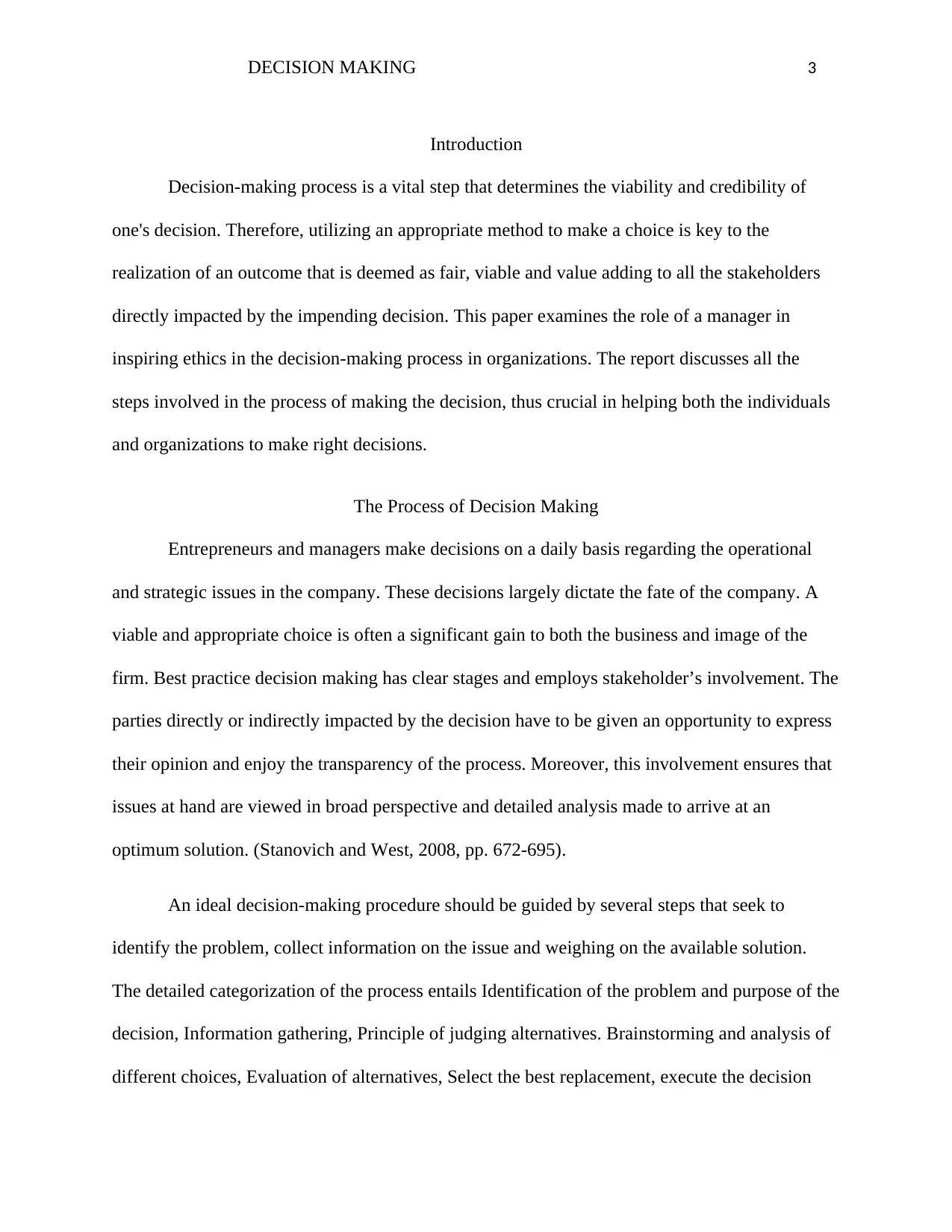
DECISION MAKING 3
Introduction
Decision-making process is a vital step that determines the viability and credibility of
one's decision. Therefore, utilizing an appropriate method to make a choice is key to the
realization of an outcome that is deemed as fair, viable and value adding to all the stakeholders
directly impacted by the impending decision. This paper examines the role of a manager in
inspiring ethics in the decision-making process in organizations. The report discusses all the
steps involved in the process of making the decision, thus crucial in helping both the individuals
and organizations to make right decisions.
The Process of Decision Making
Entrepreneurs and managers make decisions on a daily basis regarding the operational
and strategic issues in the company. These decisions largely dictate the fate of the company. A
viable and appropriate choice is often a significant gain to both the business and image of the
firm. Best practice decision making has clear stages and employs stakeholder’s involvement. The
parties directly or indirectly impacted by the decision have to be given an opportunity to express
their opinion and enjoy the transparency of the process. Moreover, this involvement ensures that
issues at hand are viewed in broad perspective and detailed analysis made to arrive at an
optimum solution. (Stanovich and West, 2008, pp. 672-695).
An ideal decision-making procedure should be guided by several steps that seek to
identify the problem, collect information on the issue and weighing on the available solution.
The detailed categorization of the process entails Identification of the problem and purpose of the
decision, Information gathering, Principle of judging alternatives. Brainstorming and analysis of
different choices, Evaluation of alternatives, Select the best replacement, execute the decision
Introduction
Decision-making process is a vital step that determines the viability and credibility of
one's decision. Therefore, utilizing an appropriate method to make a choice is key to the
realization of an outcome that is deemed as fair, viable and value adding to all the stakeholders
directly impacted by the impending decision. This paper examines the role of a manager in
inspiring ethics in the decision-making process in organizations. The report discusses all the
steps involved in the process of making the decision, thus crucial in helping both the individuals
and organizations to make right decisions.
The Process of Decision Making
Entrepreneurs and managers make decisions on a daily basis regarding the operational
and strategic issues in the company. These decisions largely dictate the fate of the company. A
viable and appropriate choice is often a significant gain to both the business and image of the
firm. Best practice decision making has clear stages and employs stakeholder’s involvement. The
parties directly or indirectly impacted by the decision have to be given an opportunity to express
their opinion and enjoy the transparency of the process. Moreover, this involvement ensures that
issues at hand are viewed in broad perspective and detailed analysis made to arrive at an
optimum solution. (Stanovich and West, 2008, pp. 672-695).
An ideal decision-making procedure should be guided by several steps that seek to
identify the problem, collect information on the issue and weighing on the available solution.
The detailed categorization of the process entails Identification of the problem and purpose of the
decision, Information gathering, Principle of judging alternatives. Brainstorming and analysis of
different choices, Evaluation of alternatives, Select the best replacement, execute the decision
⊘ This is a preview!⊘
Do you want full access?
Subscribe today to unlock all pages.

Trusted by 1+ million students worldwide
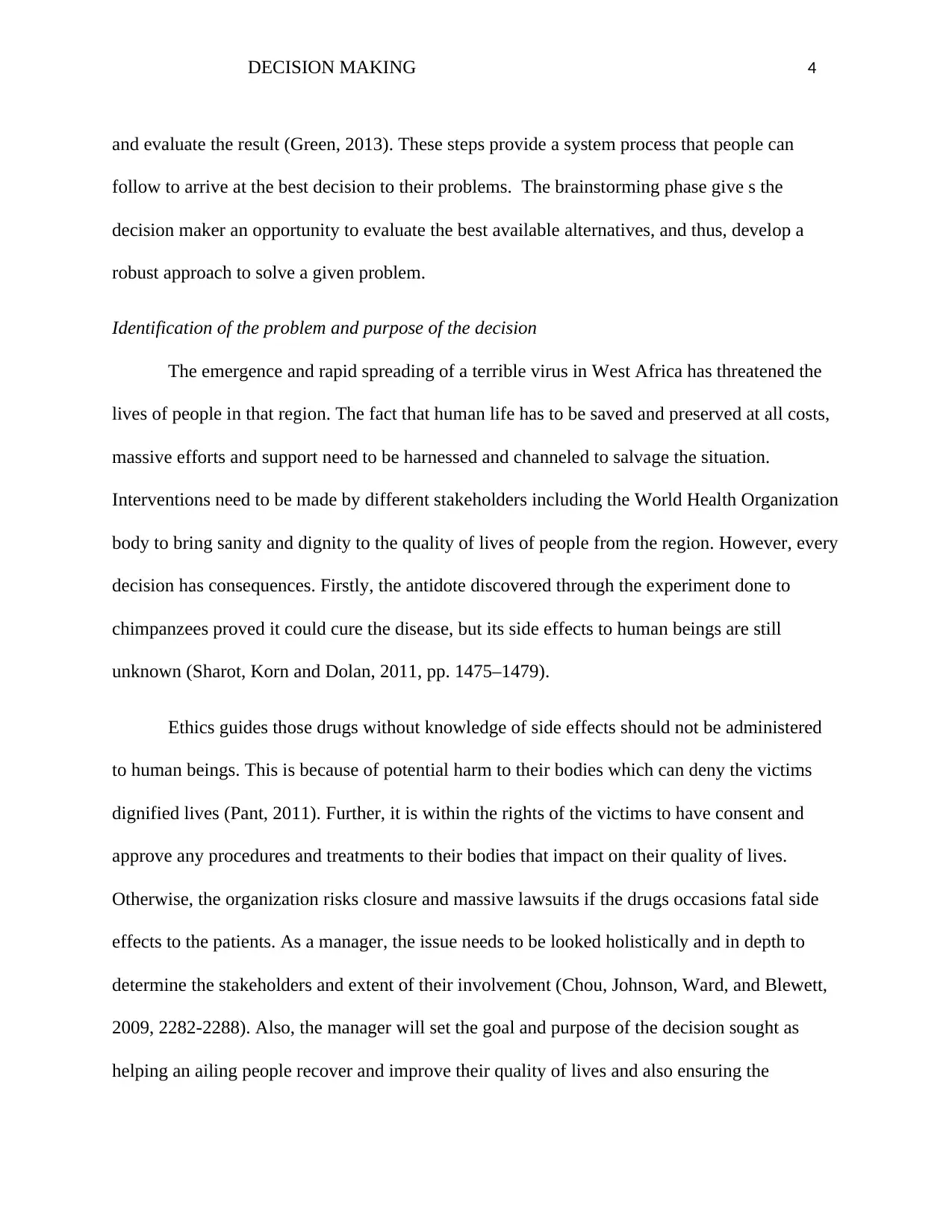
DECISION MAKING 4
and evaluate the result (Green, 2013). These steps provide a system process that people can
follow to arrive at the best decision to their problems. The brainstorming phase give s the
decision maker an opportunity to evaluate the best available alternatives, and thus, develop a
robust approach to solve a given problem.
Identification of the problem and purpose of the decision
The emergence and rapid spreading of a terrible virus in West Africa has threatened the
lives of people in that region. The fact that human life has to be saved and preserved at all costs,
massive efforts and support need to be harnessed and channeled to salvage the situation.
Interventions need to be made by different stakeholders including the World Health Organization
body to bring sanity and dignity to the quality of lives of people from the region. However, every
decision has consequences. Firstly, the antidote discovered through the experiment done to
chimpanzees proved it could cure the disease, but its side effects to human beings are still
unknown (Sharot, Korn and Dolan, 2011, pp. 1475–1479).
Ethics guides those drugs without knowledge of side effects should not be administered
to human beings. This is because of potential harm to their bodies which can deny the victims
dignified lives (Pant, 2011). Further, it is within the rights of the victims to have consent and
approve any procedures and treatments to their bodies that impact on their quality of lives.
Otherwise, the organization risks closure and massive lawsuits if the drugs occasions fatal side
effects to the patients. As a manager, the issue needs to be looked holistically and in depth to
determine the stakeholders and extent of their involvement (Chou, Johnson, Ward, and Blewett,
2009, 2282-2288). Also, the manager will set the goal and purpose of the decision sought as
helping an ailing people recover and improve their quality of lives and also ensuring the
and evaluate the result (Green, 2013). These steps provide a system process that people can
follow to arrive at the best decision to their problems. The brainstorming phase give s the
decision maker an opportunity to evaluate the best available alternatives, and thus, develop a
robust approach to solve a given problem.
Identification of the problem and purpose of the decision
The emergence and rapid spreading of a terrible virus in West Africa has threatened the
lives of people in that region. The fact that human life has to be saved and preserved at all costs,
massive efforts and support need to be harnessed and channeled to salvage the situation.
Interventions need to be made by different stakeholders including the World Health Organization
body to bring sanity and dignity to the quality of lives of people from the region. However, every
decision has consequences. Firstly, the antidote discovered through the experiment done to
chimpanzees proved it could cure the disease, but its side effects to human beings are still
unknown (Sharot, Korn and Dolan, 2011, pp. 1475–1479).
Ethics guides those drugs without knowledge of side effects should not be administered
to human beings. This is because of potential harm to their bodies which can deny the victims
dignified lives (Pant, 2011). Further, it is within the rights of the victims to have consent and
approve any procedures and treatments to their bodies that impact on their quality of lives.
Otherwise, the organization risks closure and massive lawsuits if the drugs occasions fatal side
effects to the patients. As a manager, the issue needs to be looked holistically and in depth to
determine the stakeholders and extent of their involvement (Chou, Johnson, Ward, and Blewett,
2009, 2282-2288). Also, the manager will set the goal and purpose of the decision sought as
helping an ailing people recover and improve their quality of lives and also ensuring the
Paraphrase This Document
Need a fresh take? Get an instant paraphrase of this document with our AI Paraphraser

DECISION MAKING 5
organization does not suffer a setback as the result of the decision. Another factor to the problem
is ten years to determine the safety of the drugs to human lives by the Australian authorities
(Guo, 2008, pp. 118–127).
Information gathering
Information gathering forms the next stage in this process also termed stakeholders
involvement. This an equally important step to achieve an informed and all-inclusive decision
acceptable to all the parties. The leadership of the pharmaceutical needs to assess the situation in
light of the suffering and potential loss of lives of the victims in West Africa and potential
impact of the decision made on the organization (Poudyal, Gopal, and Kedar, 2011). Information
sharing process thus facilitates the easy stages of dividing. There should a channel to overcome
the other existing aspects in the field, as a way to be continued.
Administering of the drugs to the victims will either have positive or negative
consequences to both parties. The drugs will arrest the rampant spreading of the virus but have
unforeseen side effects to the patients (Blanchfield, Heffernan, Osgood, Sheehan and Meyer,
2010). In the worst case, the side effects can be fatal and end up causing physiological illness or
deaths in the worst case. Thus, it is important how important the process of making decisions and
therefore, come up with the best way to do information gatherings.
As a manager, there is need to front the leadership of the corporation to engage the health
authority in Australia and also seek the input of the WHO World health organization body to
concluding (Perneger and Agoritsas, 2011, pp. 1411–1417). Furthermore, both the health
practitioner and health authorities in West Africa will be brought on board at this stage so that
organization does not suffer a setback as the result of the decision. Another factor to the problem
is ten years to determine the safety of the drugs to human lives by the Australian authorities
(Guo, 2008, pp. 118–127).
Information gathering
Information gathering forms the next stage in this process also termed stakeholders
involvement. This an equally important step to achieve an informed and all-inclusive decision
acceptable to all the parties. The leadership of the pharmaceutical needs to assess the situation in
light of the suffering and potential loss of lives of the victims in West Africa and potential
impact of the decision made on the organization (Poudyal, Gopal, and Kedar, 2011). Information
sharing process thus facilitates the easy stages of dividing. There should a channel to overcome
the other existing aspects in the field, as a way to be continued.
Administering of the drugs to the victims will either have positive or negative
consequences to both parties. The drugs will arrest the rampant spreading of the virus but have
unforeseen side effects to the patients (Blanchfield, Heffernan, Osgood, Sheehan and Meyer,
2010). In the worst case, the side effects can be fatal and end up causing physiological illness or
deaths in the worst case. Thus, it is important how important the process of making decisions and
therefore, come up with the best way to do information gatherings.
As a manager, there is need to front the leadership of the corporation to engage the health
authority in Australia and also seek the input of the WHO World health organization body to
concluding (Perneger and Agoritsas, 2011, pp. 1411–1417). Furthermore, both the health
practitioner and health authorities in West Africa will be brought on board at this stage so that
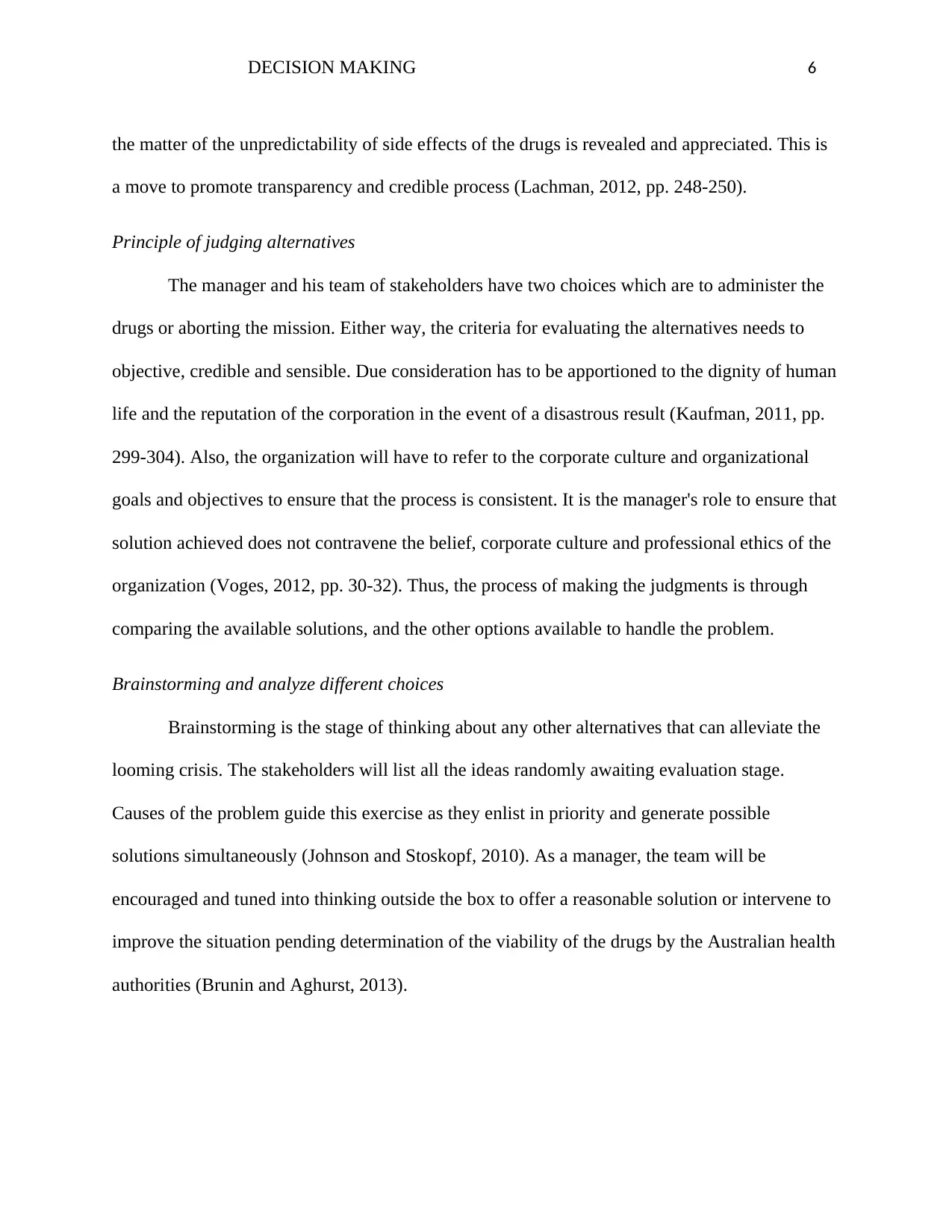
DECISION MAKING 6
the matter of the unpredictability of side effects of the drugs is revealed and appreciated. This is
a move to promote transparency and credible process (Lachman, 2012, pp. 248-250).
Principle of judging alternatives
The manager and his team of stakeholders have two choices which are to administer the
drugs or aborting the mission. Either way, the criteria for evaluating the alternatives needs to
objective, credible and sensible. Due consideration has to be apportioned to the dignity of human
life and the reputation of the corporation in the event of a disastrous result (Kaufman, 2011, pp.
299-304). Also, the organization will have to refer to the corporate culture and organizational
goals and objectives to ensure that the process is consistent. It is the manager's role to ensure that
solution achieved does not contravene the belief, corporate culture and professional ethics of the
organization (Voges, 2012, pp. 30-32). Thus, the process of making the judgments is through
comparing the available solutions, and the other options available to handle the problem.
Brainstorming and analyze different choices
Brainstorming is the stage of thinking about any other alternatives that can alleviate the
looming crisis. The stakeholders will list all the ideas randomly awaiting evaluation stage.
Causes of the problem guide this exercise as they enlist in priority and generate possible
solutions simultaneously (Johnson and Stoskopf, 2010). As a manager, the team will be
encouraged and tuned into thinking outside the box to offer a reasonable solution or intervene to
improve the situation pending determination of the viability of the drugs by the Australian health
authorities (Brunin and Aghurst, 2013).
the matter of the unpredictability of side effects of the drugs is revealed and appreciated. This is
a move to promote transparency and credible process (Lachman, 2012, pp. 248-250).
Principle of judging alternatives
The manager and his team of stakeholders have two choices which are to administer the
drugs or aborting the mission. Either way, the criteria for evaluating the alternatives needs to
objective, credible and sensible. Due consideration has to be apportioned to the dignity of human
life and the reputation of the corporation in the event of a disastrous result (Kaufman, 2011, pp.
299-304). Also, the organization will have to refer to the corporate culture and organizational
goals and objectives to ensure that the process is consistent. It is the manager's role to ensure that
solution achieved does not contravene the belief, corporate culture and professional ethics of the
organization (Voges, 2012, pp. 30-32). Thus, the process of making the judgments is through
comparing the available solutions, and the other options available to handle the problem.
Brainstorming and analyze different choices
Brainstorming is the stage of thinking about any other alternatives that can alleviate the
looming crisis. The stakeholders will list all the ideas randomly awaiting evaluation stage.
Causes of the problem guide this exercise as they enlist in priority and generate possible
solutions simultaneously (Johnson and Stoskopf, 2010). As a manager, the team will be
encouraged and tuned into thinking outside the box to offer a reasonable solution or intervene to
improve the situation pending determination of the viability of the drugs by the Australian health
authorities (Brunin and Aghurst, 2013).
⊘ This is a preview!⊘
Do you want full access?
Subscribe today to unlock all pages.

Trusted by 1+ million students worldwide
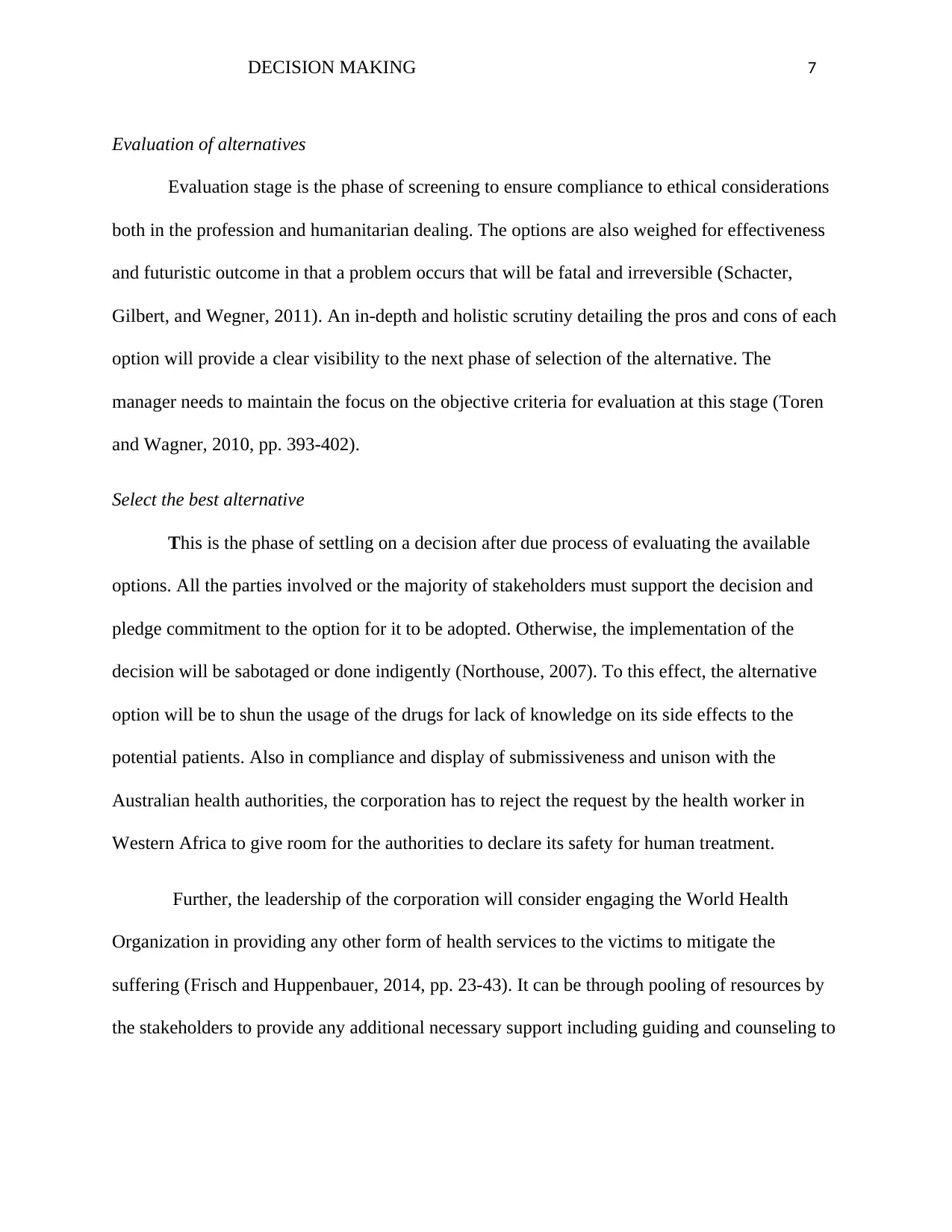
DECISION MAKING 7
Evaluation of alternatives
Evaluation stage is the phase of screening to ensure compliance to ethical considerations
both in the profession and humanitarian dealing. The options are also weighed for effectiveness
and futuristic outcome in that a problem occurs that will be fatal and irreversible (Schacter,
Gilbert, and Wegner, 2011). An in-depth and holistic scrutiny detailing the pros and cons of each
option will provide a clear visibility to the next phase of selection of the alternative. The
manager needs to maintain the focus on the objective criteria for evaluation at this stage (Toren
and Wagner, 2010, pp. 393-402).
Select the best alternative
This is the phase of settling on a decision after due process of evaluating the available
options. All the parties involved or the majority of stakeholders must support the decision and
pledge commitment to the option for it to be adopted. Otherwise, the implementation of the
decision will be sabotaged or done indigently (Northouse, 2007). To this effect, the alternative
option will be to shun the usage of the drugs for lack of knowledge on its side effects to the
potential patients. Also in compliance and display of submissiveness and unison with the
Australian health authorities, the corporation has to reject the request by the health worker in
Western Africa to give room for the authorities to declare its safety for human treatment.
Further, the leadership of the corporation will consider engaging the World Health
Organization in providing any other form of health services to the victims to mitigate the
suffering (Frisch and Huppenbauer, 2014, pp. 23-43). It can be through pooling of resources by
the stakeholders to provide any additional necessary support including guiding and counseling to
Evaluation of alternatives
Evaluation stage is the phase of screening to ensure compliance to ethical considerations
both in the profession and humanitarian dealing. The options are also weighed for effectiveness
and futuristic outcome in that a problem occurs that will be fatal and irreversible (Schacter,
Gilbert, and Wegner, 2011). An in-depth and holistic scrutiny detailing the pros and cons of each
option will provide a clear visibility to the next phase of selection of the alternative. The
manager needs to maintain the focus on the objective criteria for evaluation at this stage (Toren
and Wagner, 2010, pp. 393-402).
Select the best alternative
This is the phase of settling on a decision after due process of evaluating the available
options. All the parties involved or the majority of stakeholders must support the decision and
pledge commitment to the option for it to be adopted. Otherwise, the implementation of the
decision will be sabotaged or done indigently (Northouse, 2007). To this effect, the alternative
option will be to shun the usage of the drugs for lack of knowledge on its side effects to the
potential patients. Also in compliance and display of submissiveness and unison with the
Australian health authorities, the corporation has to reject the request by the health worker in
Western Africa to give room for the authorities to declare its safety for human treatment.
Further, the leadership of the corporation will consider engaging the World Health
Organization in providing any other form of health services to the victims to mitigate the
suffering (Frisch and Huppenbauer, 2014, pp. 23-43). It can be through pooling of resources by
the stakeholders to provide any additional necessary support including guiding and counseling to
Paraphrase This Document
Need a fresh take? Get an instant paraphrase of this document with our AI Paraphraser

DECISION MAKING 8
the victims. Thus, the availability of the choices in the process of making the decision important
give an opportunity for the other people or projects to take form.
Execute the decision
The leadership of the corporation through the manager will have to directly respond to
the colleague health worker revealing the position of the company and justifying the same.
Importantly, there should be plans for set activities made to action the decision reached during
the decision making process. The manner of execution of the judgment is utterly essential
because it determines the attitude and understanding of the affected parties (Garman, Johnson,
and Royer, 2011).
The manager will have to arrange a sit down meeting with his colleague due to the grave
matter of the situation and politely decline the request and justify the decision. Meanwhile, he
will have to reveal the plans of the corporation to engage other stakeholders in intervening in that
situation and contributing as much to mitigate the suffering of the victims. The brainstorming
phase identified an option of offering another health assistance including guiding and counseling
to the affected people to improve their quality of lives (Thompson, 2008).
Evaluate the result
Finally, the result of the decision is analyzed at this stage in time. Gaps and corrective
and preventive measures noted for futuristic purposes. The feedback from the stakeholders forms
the basis of evaluation of the appropriateness and effectiveness of the decision. In this case, the
result is anticipated to be overwhelmingly positive because of ethical professionalism and due
process of stakeholder’s involvement. Further, the team went an extra mile to offer services that
will improve the situation pending the determination of the safety of the drugs. The result is the
the victims. Thus, the availability of the choices in the process of making the decision important
give an opportunity for the other people or projects to take form.
Execute the decision
The leadership of the corporation through the manager will have to directly respond to
the colleague health worker revealing the position of the company and justifying the same.
Importantly, there should be plans for set activities made to action the decision reached during
the decision making process. The manner of execution of the judgment is utterly essential
because it determines the attitude and understanding of the affected parties (Garman, Johnson,
and Royer, 2011).
The manager will have to arrange a sit down meeting with his colleague due to the grave
matter of the situation and politely decline the request and justify the decision. Meanwhile, he
will have to reveal the plans of the corporation to engage other stakeholders in intervening in that
situation and contributing as much to mitigate the suffering of the victims. The brainstorming
phase identified an option of offering another health assistance including guiding and counseling
to the affected people to improve their quality of lives (Thompson, 2008).
Evaluate the result
Finally, the result of the decision is analyzed at this stage in time. Gaps and corrective
and preventive measures noted for futuristic purposes. The feedback from the stakeholders forms
the basis of evaluation of the appropriateness and effectiveness of the decision. In this case, the
result is anticipated to be overwhelmingly positive because of ethical professionalism and due
process of stakeholder’s involvement. Further, the team went an extra mile to offer services that
will improve the situation pending the determination of the safety of the drugs. The result is the
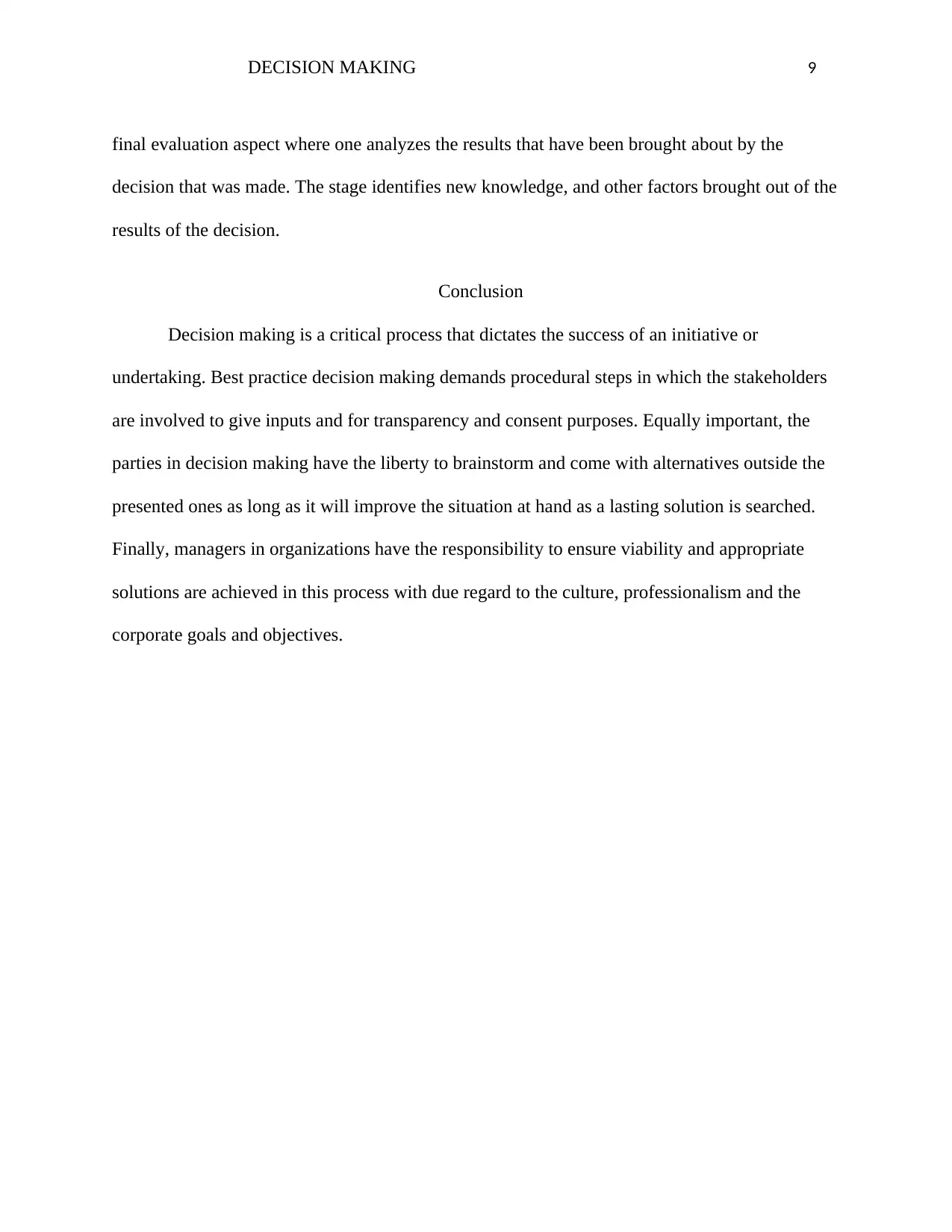
DECISION MAKING 9
final evaluation aspect where one analyzes the results that have been brought about by the
decision that was made. The stage identifies new knowledge, and other factors brought out of the
results of the decision.
Conclusion
Decision making is a critical process that dictates the success of an initiative or
undertaking. Best practice decision making demands procedural steps in which the stakeholders
are involved to give inputs and for transparency and consent purposes. Equally important, the
parties in decision making have the liberty to brainstorm and come with alternatives outside the
presented ones as long as it will improve the situation at hand as a lasting solution is searched.
Finally, managers in organizations have the responsibility to ensure viability and appropriate
solutions are achieved in this process with due regard to the culture, professionalism and the
corporate goals and objectives.
final evaluation aspect where one analyzes the results that have been brought about by the
decision that was made. The stage identifies new knowledge, and other factors brought out of the
results of the decision.
Conclusion
Decision making is a critical process that dictates the success of an initiative or
undertaking. Best practice decision making demands procedural steps in which the stakeholders
are involved to give inputs and for transparency and consent purposes. Equally important, the
parties in decision making have the liberty to brainstorm and come with alternatives outside the
presented ones as long as it will improve the situation at hand as a lasting solution is searched.
Finally, managers in organizations have the responsibility to ensure viability and appropriate
solutions are achieved in this process with due regard to the culture, professionalism and the
corporate goals and objectives.
⊘ This is a preview!⊘
Do you want full access?
Subscribe today to unlock all pages.

Trusted by 1+ million students worldwide
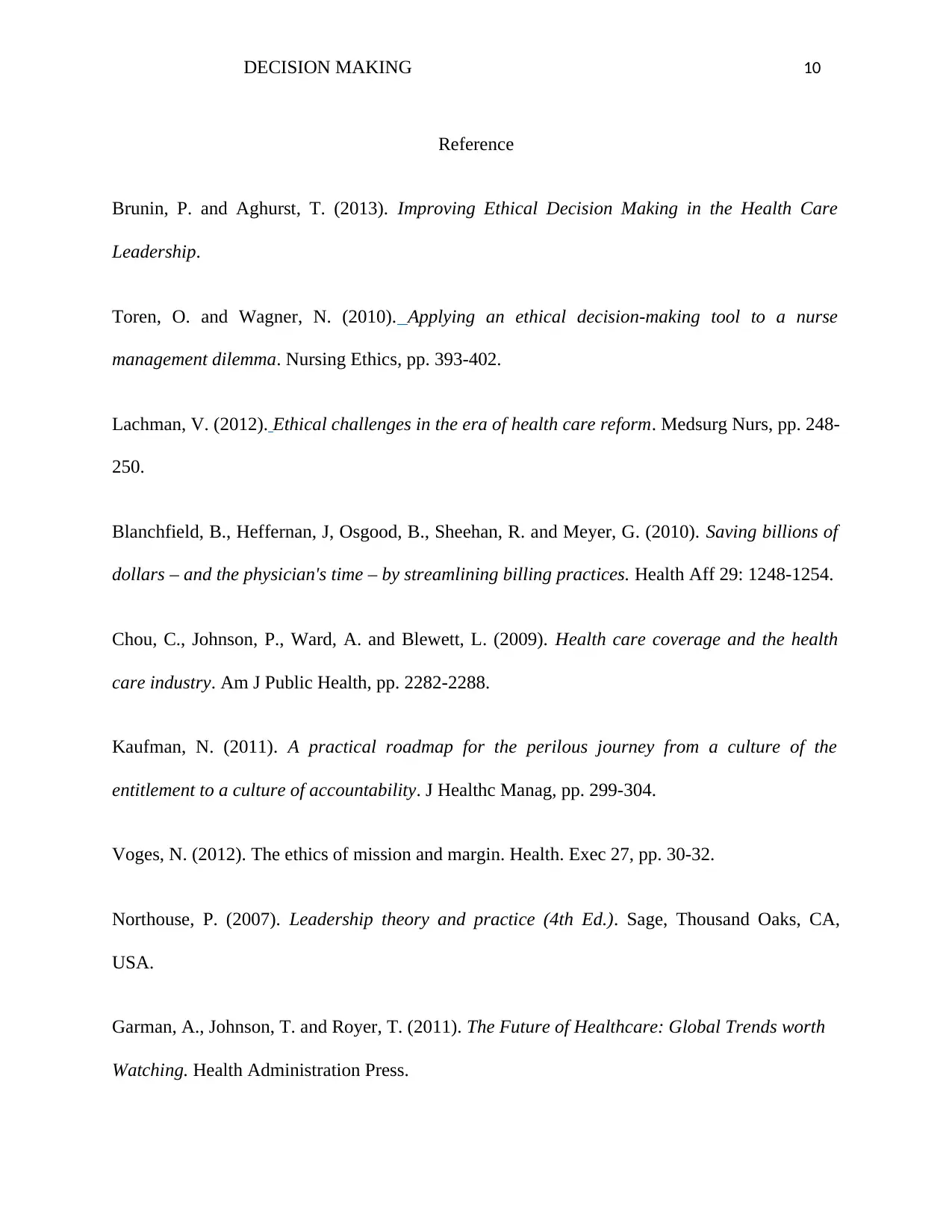
DECISION MAKING 10
Reference
Brunin, P. and Aghurst, T. (2013). Improving Ethical Decision Making in the Health Care
Leadership.
Toren, O. and Wagner, N. (2010). Applying an ethical decision-making tool to a nurse
management dilemma. Nursing Ethics, pp. 393-402.
Lachman, V. (2012). Ethical challenges in the era of health care reform. Medsurg Nurs, pp. 248-
250.
Blanchfield, B., Heffernan, J, Osgood, B., Sheehan, R. and Meyer, G. (2010). Saving billions of
dollars – and the physician's time – by streamlining billing practices. Health Aff 29: 1248-1254.
Chou, C., Johnson, P., Ward, A. and Blewett, L. (2009). Health care coverage and the health
care industry. Am J Public Health, pp. 2282-2288.
Kaufman, N. (2011). A practical roadmap for the perilous journey from a culture of the
entitlement to a culture of accountability. J Healthc Manag, pp. 299-304.
Voges, N. (2012). The ethics of mission and margin. Health. Exec 27, pp. 30-32.
Northouse, P. (2007). Leadership theory and practice (4th Ed.). Sage, Thousand Oaks, CA,
USA.
Garman, A., Johnson, T. and Royer, T. (2011). The Future of Healthcare: Global Trends worth
Watching. Health Administration Press.
Reference
Brunin, P. and Aghurst, T. (2013). Improving Ethical Decision Making in the Health Care
Leadership.
Toren, O. and Wagner, N. (2010). Applying an ethical decision-making tool to a nurse
management dilemma. Nursing Ethics, pp. 393-402.
Lachman, V. (2012). Ethical challenges in the era of health care reform. Medsurg Nurs, pp. 248-
250.
Blanchfield, B., Heffernan, J, Osgood, B., Sheehan, R. and Meyer, G. (2010). Saving billions of
dollars – and the physician's time – by streamlining billing practices. Health Aff 29: 1248-1254.
Chou, C., Johnson, P., Ward, A. and Blewett, L. (2009). Health care coverage and the health
care industry. Am J Public Health, pp. 2282-2288.
Kaufman, N. (2011). A practical roadmap for the perilous journey from a culture of the
entitlement to a culture of accountability. J Healthc Manag, pp. 299-304.
Voges, N. (2012). The ethics of mission and margin. Health. Exec 27, pp. 30-32.
Northouse, P. (2007). Leadership theory and practice (4th Ed.). Sage, Thousand Oaks, CA,
USA.
Garman, A., Johnson, T. and Royer, T. (2011). The Future of Healthcare: Global Trends worth
Watching. Health Administration Press.
Paraphrase This Document
Need a fresh take? Get an instant paraphrase of this document with our AI Paraphraser
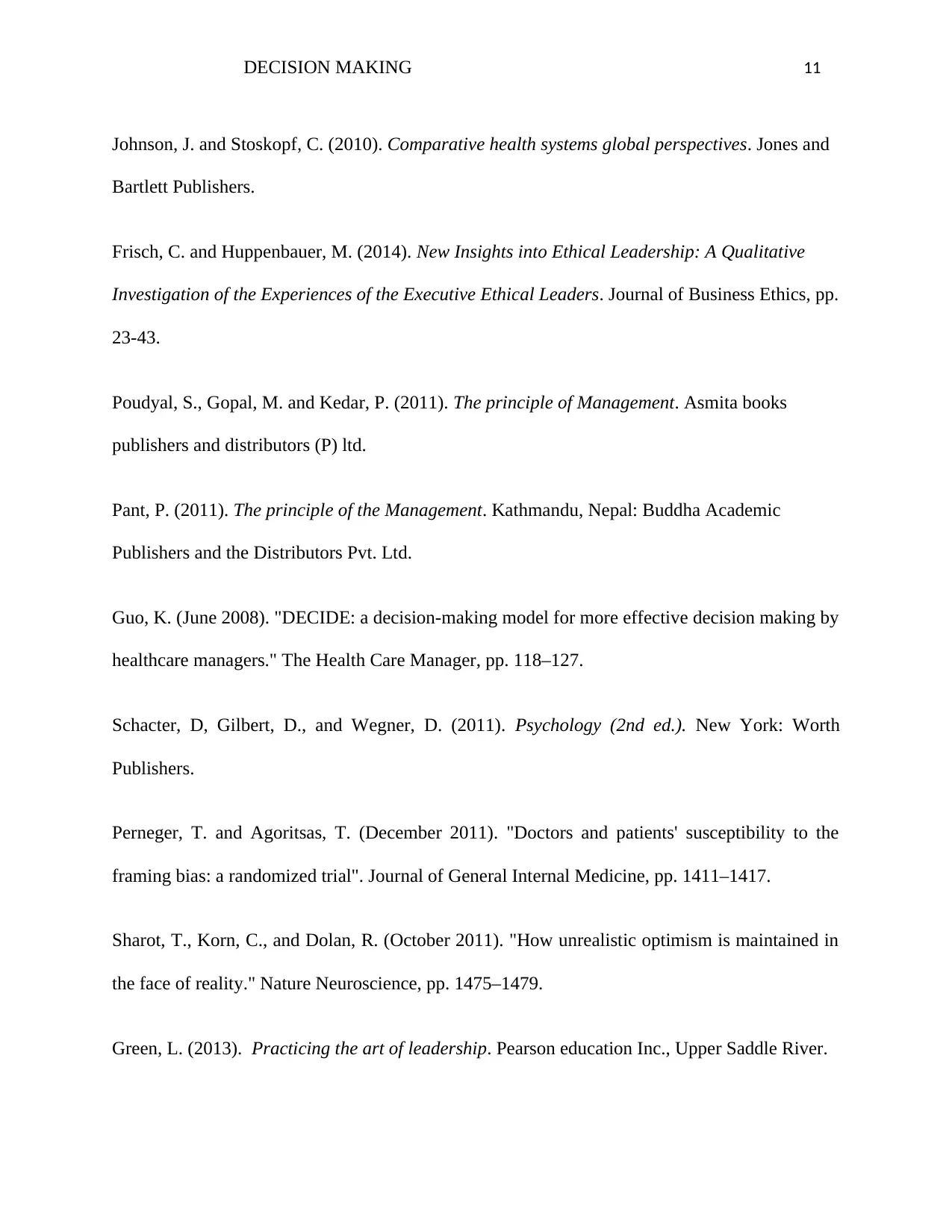
DECISION MAKING 11
Johnson, J. and Stoskopf, C. (2010). Comparative health systems global perspectives. Jones and
Bartlett Publishers.
Frisch, C. and Huppenbauer, M. (2014). New Insights into Ethical Leadership: A Qualitative
Investigation of the Experiences of the Executive Ethical Leaders. Journal of Business Ethics, pp.
23-43.
Poudyal, S., Gopal, M. and Kedar, P. (2011). The principle of Management. Asmita books
publishers and distributors (P) ltd.
Pant, P. (2011). The principle of the Management. Kathmandu, Nepal: Buddha Academic
Publishers and the Distributors Pvt. Ltd.
Guo, K. (June 2008). "DECIDE: a decision-making model for more effective decision making by
healthcare managers." The Health Care Manager, pp. 118–127.
Schacter, D, Gilbert, D., and Wegner, D. (2011). Psychology (2nd ed.). New York: Worth
Publishers.
Perneger, T. and Agoritsas, T. (December 2011). "Doctors and patients' susceptibility to the
framing bias: a randomized trial". Journal of General Internal Medicine, pp. 1411–1417.
Sharot, T., Korn, C., and Dolan, R. (October 2011). "How unrealistic optimism is maintained in
the face of reality." Nature Neuroscience, pp. 1475–1479.
Green, L. (2013). Practicing the art of leadership. Pearson education Inc., Upper Saddle River.
Johnson, J. and Stoskopf, C. (2010). Comparative health systems global perspectives. Jones and
Bartlett Publishers.
Frisch, C. and Huppenbauer, M. (2014). New Insights into Ethical Leadership: A Qualitative
Investigation of the Experiences of the Executive Ethical Leaders. Journal of Business Ethics, pp.
23-43.
Poudyal, S., Gopal, M. and Kedar, P. (2011). The principle of Management. Asmita books
publishers and distributors (P) ltd.
Pant, P. (2011). The principle of the Management. Kathmandu, Nepal: Buddha Academic
Publishers and the Distributors Pvt. Ltd.
Guo, K. (June 2008). "DECIDE: a decision-making model for more effective decision making by
healthcare managers." The Health Care Manager, pp. 118–127.
Schacter, D, Gilbert, D., and Wegner, D. (2011). Psychology (2nd ed.). New York: Worth
Publishers.
Perneger, T. and Agoritsas, T. (December 2011). "Doctors and patients' susceptibility to the
framing bias: a randomized trial". Journal of General Internal Medicine, pp. 1411–1417.
Sharot, T., Korn, C., and Dolan, R. (October 2011). "How unrealistic optimism is maintained in
the face of reality." Nature Neuroscience, pp. 1475–1479.
Green, L. (2013). Practicing the art of leadership. Pearson education Inc., Upper Saddle River.

DECISION MAKING 12
Thompson, L. (2008). Making the Team: A guide for Managers (3rd Ed.) Prentice, NJ.
Stanovich, K. and West, R. (2008). On the relative independence of the thinking biases and
cognitive ability. Journal of Personality and Social Psychology, pp. 672-695.
Thompson, L. (2008). Making the Team: A guide for Managers (3rd Ed.) Prentice, NJ.
Stanovich, K. and West, R. (2008). On the relative independence of the thinking biases and
cognitive ability. Journal of Personality and Social Psychology, pp. 672-695.
⊘ This is a preview!⊘
Do you want full access?
Subscribe today to unlock all pages.

Trusted by 1+ million students worldwide
1 out of 13
Related Documents
Your All-in-One AI-Powered Toolkit for Academic Success.
+13062052269
info@desklib.com
Available 24*7 on WhatsApp / Email
![[object Object]](/_next/static/media/star-bottom.7253800d.svg)
Unlock your academic potential
Copyright © 2020–2025 A2Z Services. All Rights Reserved. Developed and managed by ZUCOL.





